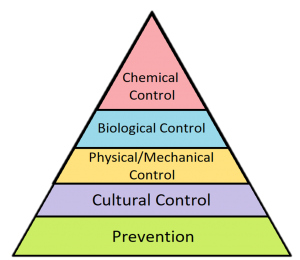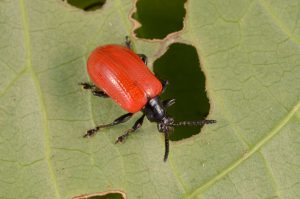Blog by Morgan Pinkerton and Tina McIntyre, UF/IFAS Extension Seminole County
What is integrated pest management?

Integrated pest management (IPM) is the combination of various tactics to manage pest populations. You can think of it like a tool box with many different pest management tools. You might use one or more of these tools to fix your pest problem. This approach to pest management aims to provide the best control while considering economic and environmental sustainability.
So what does this have to do with invasive weeds? Well, weeds are a pest! We can use IPM strategies to help stop the spread of invasive weeds and control them once they establish in new areas.
What are the tools in our IPM tool box for controlling invasive weeds?
Prevention:
Prevention is the very first thing we should consider. It focuses on keeping the weeds from becoming a problem. Avoid introducing weeds or weed seed to new areas. For example, do not plant species that are known invasives. It also means purchasing seeds or potted plants from trusted sources. Invasive species may be mixed in with the seeds or be in the soil of the potted plants. Cleaning is also important in prevention as some invasive species hitchhike on equipment or other objects and move to other areas.
Cultural control:
Cultural control focuses on environmental conditions of an area. We want to make the area most suitable for our good plants and least suitable for our invasive weeds. With cultural control, we focus on fertilization, irrigation, space, soil pH and more. Is the site favoring our invasive species? If it is, what can we do to encourage native plants to survive? If we remove an invasive species from an area, what can we do to promote our native plants to reestablish?
Physical/mechanical control:
Physical or mechanical control is an often used management strategy for invasive weeds. It is where we get our hands dirty or bring in equipment to help. Hand removal of invasive weeds is a large aspect of physical/mechanical control. At some sites, we may also use solarization, tillage, cultivation, mowing and more.
Biological control:

Biological control is the use of one organism to control another. A biological control agent might be a predator, a parasitoid or a pathogen that harms our target pest. For invasive species, there is a lot of research that goes in to the release of a biological control agent. Scientists will go to the native range of the invasive plant and look for organisms that eat or kill it. We look for a biological control agent that is specific to that invasive species so that the agent doesn’t also harm our desirable plants. It can take nearly a decade to find a suitable biological control, perform all the necessary research, and get approval to release it.
In Florida, the use of the air potato beetle to control air potato is a great example of biological control. This beetle feeds on only air potato so over time, it helps reduce the population of air potato plants in our environment.
Chemical control:
Chemical control is the use of pesticides to control pests. Herbicides are a type of pesticide that specifically controls plants. Some herbicides are broad spectrum, and they kill many different kinds of plants. Others are selective and only kill certain types of plants. In invasive weed management, herbicides are often used to kill invasive species that are spread over a wide area. Herbicides can be very useful and save time and money in management efforts. However, pesticides can be dangerous chemicals so it is important to practice safety and follow the label when using these products. It is important to remember that herbicides can have effects on non-target plants, so sometimes they can cause more harm to ecosystems.
Why is prevention so critical for invasive species?
Invasive species are non-native, meaning they were introduced to the area. Many invasive weeds are very difficult to manage once they become a problem. Cultural, physical/mechanical, biological and chemical control all take time, money and other resources. They also might need to be continued year after year to prevent the invasive species from getting out of control again. Realistically, it is hard to find every single plant (and seed!) and destroy them once they have established. By keeping an invasive species out, we keep the problem from starting in the first place.
Federal and state governments pay attention to weeds that could potentially be invasive if introduced. They keep watch lists of the worst species and also devote a lot of resources to keeping them out. If an invasive species is found in a new area for the first time, the government might enact a quarantine on the area. A quarantine can keep the invasive species from spreading or moving to new areas. There might also be eradication efforts. If the population of the invasive species is small, they might be able to remove all of it completely. However, sometimes invasive species go unnoticed until they are already a major problem. This shifts the focus to management rather than prevention efforts like quarantine or eradication.
Interested in participating in Weed Wrangle© Week 2021?
Check out this article for more information on what is going on locally this week. Be sure to catch all the other cool resources we are sharing this week on our Central Florida CISMA Facebook page!
More Resources
- Central Florida Cooperative Invasive Species Management Area
- Florida Invasive Species Partnership
- Florida First Detector Program
- Invasive Weeds EDIS Documents
- UF Center for Aquatic and Invasive Plants
- WeedWrangle.org
 0
0
